#Epinephrine
Explore tagged Tumblr posts
Note
Could you tell us about the pharmaceutical history of epinephrine please?
There's so much about the history of epinephrine that I'm also going to refer you to the Sawbones episode about it. You can listen to it here:
30 notes
·
View notes
Photo

Access to epinephrine auto-injectors by country
49 notes
·
View notes
Text
Quebec schools could soon be instructed to keep epinephrine injectors, or EpiPens, on hand for emergency use. The recommendation is part of school-based care guidelines currently being developed by Quebec's education and health ministries, The Canadian Press has learned. Part of the guide will deal with distributing and administering medications, such as Epipens, in emergencies. Some schools already keep Epipens on site, but it's the legal responsibility of students with allergies to bring their own to school.
Full article
Tagging: @politicsofcanada
#cdnpoli#canadian politics#canadian news#canada#canadian#québec#quebec#epipens#epinephrine#schools#education#allergies#anaphylaxis#health and safety
94 notes
·
View notes
Text
Epinephrine

#medblr#studyblr#notes#my notes#medical notes#med notes#medblr notes#epinephrine#epinephrine notes#pharmacology#pharmacology notes#pharm#pharm notes#pharma#pharma notes
7 notes
·
View notes
Text
The structure of salbutamol (shown below) is patterned after that of epinephrine (adrenaline) and, like many drugs, salbutamol is a polyfunctional compound (it contains more than one type of functional group).

"Chemistry" 2e - Blackman, A., Bottle, S., Schmid, S., Mocerino, M., Wille, U.
#book quotes#chemistry#nonfiction#textbook#chemical structure#salbutamol#albuterol#ventolin#epinephrine#adrenaline#drugs#polyfunctional#functional group#alcohol#phenol#amine
4 notes
·
View notes
Text

Epinephrine for anaphylaxis explained
2 notes
·
View notes
Photo

Julius Axelrod was born on May 30, 1912. An American biochemist, he won a share of the Nobel Prize in Physiology or Medicine in 1970 along with Bernard Katz and Ulf von Euler, for his work on the release and reuptake of catecholamine neurotransmitters, a class of chemicals in the brain that include epinephrine, norepinephrine, and, as was later discovered, dopamine. This laid the groundwork for the antidepressants we have today. Axelrod also made major contributions to the understanding of the pineal gland and how it is regulated during the sleep-wake cycle.
#julius axelrod#medicine#neurotransmitters#if you can't make your own neurotransmitters store bought is fine#epinephrine#norepinephrine#dopamine#antidepressants#chemistry#thanks this guy#Nobel Prize#nobel prize winners#science#science birthdays#science history#on this day#on this day in science history
3 notes
·
View notes
Text

Paraphrasing Jeffrey K Aronson
All drugs have at least three different names:
The chemical name, whose form generally follows the rules issued by the International Union of Pure and Applied Chemistry (IUPAC); in this case, that is dihydroxyphenylmethylaminoethanol.
The approved (official or generic) name, which is usually the World Health Organization's international non-proprietary name (INN); in this case, that is epinephrine.
The proprietary (brand or trade) name, which is the name given by a pharmaceutical manufacturer; in this case, that is Adrenaline (also EpiPen for intramuscular injection, or Eppy or Simplene eyedrops, among others).
Other examples include:
N-acetyl-p-aminophenol / acetaminophen / Tylenol
(RS)-2-(4-(2-methylpropyl)phenyl)propanoic acid / ibuprofen / Advil
2-acetoxybenzoic acid / acetylsalicylic acid / Aspirin

no idea where i was going with this but i abandoned it at the most disconcerting moment possible
#ask#trademarks#trademark erosion#genericization#genericized trademarks#epinephrine#Adrenaline#acetaminophen#Tylenol#ibuprofen#Advil#Motrin#acetylsalicylic acid#Aspirin#brand names#medicine#generic drugs#generic medicine#brand name drugs#brand name medicine
102K notes
·
View notes
Text

The Science Diaries of S. Sunkavally, p438.
#tetraploid#fertilized egg#Turner's syndrome#twins#hypertension#kidney#brachydactyly#hookworm infection#septal defect#epinephrine#radon#caves#fever#viscosity of blood#myxoma#left atrium#erythrocyte#neutral buoyancy#solubility of immunoglobulins#endothelial cells#march hemoglobinuria#polycythemia#satyendra sunkavally#theoretical biology#manuscript#cursive handwriting
0 notes
Text
Exciting News! FDA Approves First Needle-Free Epinephrine
For decades, people with food allergies and their caregivers have been hoping for needle-free epinephrine options to respond to their severe allergic reactions, called anaphylaxis. Last Friday, the U.S Food and Drug Administration (FDA) answered those hopes by approving neffy® – the first non-injectable emergency treatment for people with life-threatening allergies. Neffy, made by ARS…

View On WordPress
#ai#Anaphylaxis#autoinjector#dairy allergy#eai#emergency#epinephrine#epipen#food allergies#food allergy#nasal spray#nose#peanut allergy#reaction#serious#severe#spray
0 notes
Text
My Lifesaver: The Adrenaline Auto-injector
Daily writing promptWhat is the most important thing to carry with you all the time?View all responses For most people, the most important thing that they carry all the time is probably their phone, wallet, or keys. But for me, my adrenaline auto-injector is far more crucial. Image found on Internet Living with multiple life-threatening allergies means constantly being aware of potential…

View On WordPress
#adrenaline#adrenaline auto-injector#allergic reaction#allergy#anaphylaxis#dailyprompt#dailyprompt-2025#epinephrine#epinephrine auto-injector#hormone#independence#preparedness#Raffaello Palandri#responsibility
0 notes
Text
for someone who has never had to use this or other medical needles, can someone please give me clearer detail on how hard "slam"/"swing and push firmly" means? should it change based on clothing worn, body weight, adult, senior, or child?
Anyone can help!

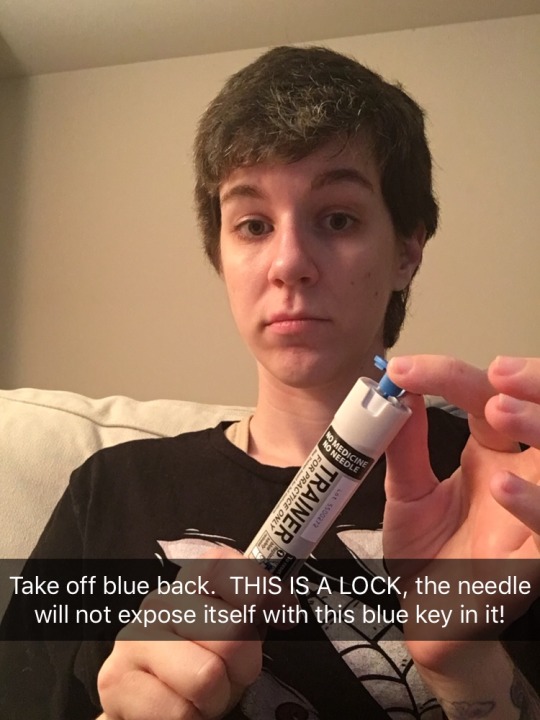
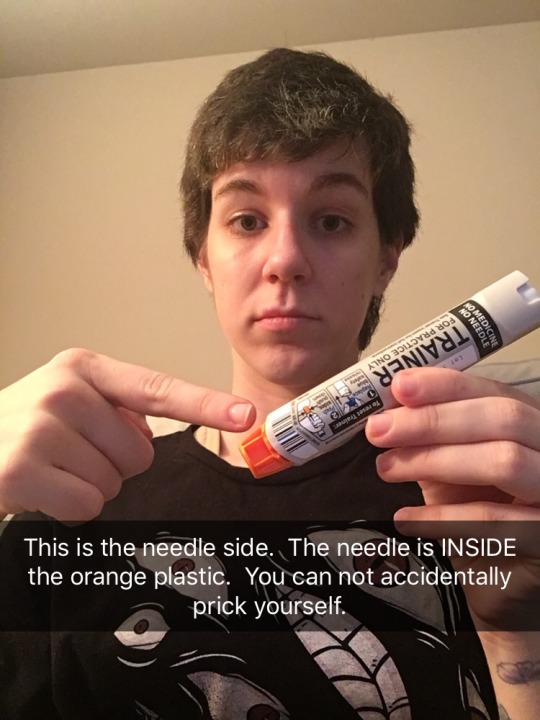


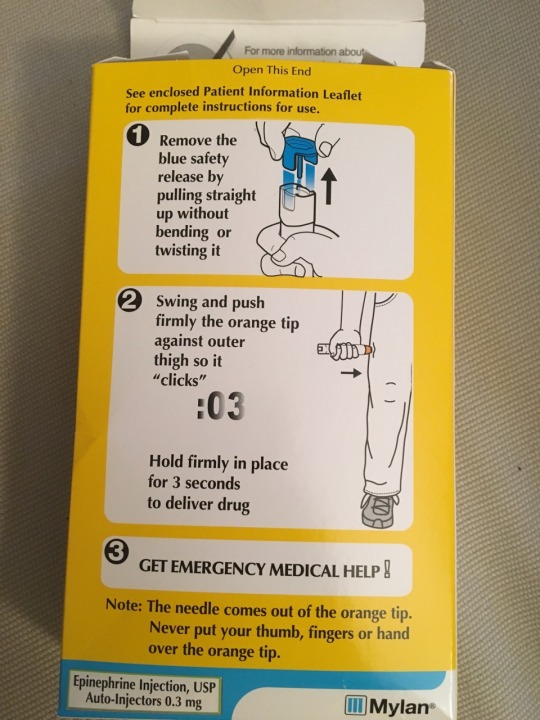
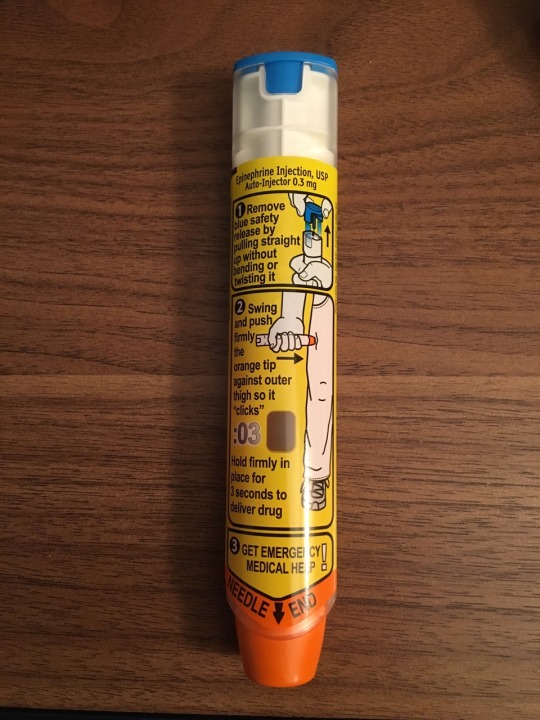
(Real pen the last picture)
It is important for EVERYONE to know how to help ANYONE. Not everyone can give them selves their medicine under every circumstance. Be educated, help out.
In the last year, i have gotten about five new violent allergies from foods i used to be able to eat. Next time i eat a fruit, my throat could close. I may not be able to inject myself. My boyfriend and i played with my trainer pen for like 30 minutes. He knows how to inject it. I know how. This is important.
236K notes
·
View notes
Note
isn't adrenaline the name of a hormone produced by the adrenal glands? how can it be a trademark owned by a company? isn't that like trademarking mucus or blood
Paraphrasing Jeffrey K Aronson
All drugs have at least three different names:
The chemical name, whose form generally follows the rules issued by the International Union of Pure and Applied Chemistry (IUPAC); in this case, that is dihydroxyphenylmethylaminoethanol.
The approved (official or generic) name, which is usually the World Health Organization's international non-proprietary name (INN); in this case, that is epinephrine.
The proprietary (brand or trade) name, which is the name given by a pharmaceutical manufacturer; in this case, that is Adrenaline (also EpiPen for intramuscular injection, or Eppy or Simplene eyedrops, among others).
Other examples include:
N-acetyl-p-aminophenol / acetaminophen / Tylenol
(RS)-2-(4-(2-methylpropyl)phenyl)propanoic acid / ibuprofen / Advil
2-acetoxybenzoic acid / acetylsalicylic acid / Aspirin
0 notes
Text
What to expect from allergy testing: Before, during, and after
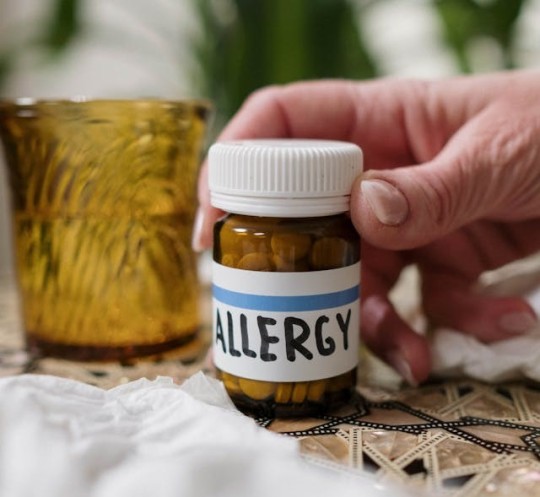
"What to expect from allergy testing: Before, during, and after" Disclaimer: None of the information provided in these posts should be taken as medical advice. Please consult with your doctor before trying recommendations or if you have concern Some posts may contain affiliate or third-party links. When you and your immunologist determine allergy testing is necessary, here are some things you can expect. In all of them, they will record your detailed medical history, including family history, and may perform a physical examination to look for clues regarding your reactions. Trigger warning: We���re going to be talking about needles very soon, so please proceed with that in mind. If you need to stop reading, that’s okay. Tune in for my next post instead. As I mentioned in the last post, I didn’t get allergy tested until later in life. And, while I’m not afraid of needles, oof, there’s a lot of needles involved in allergy testing (well, in most of the tests).
How to prepare for a food allergy test
Regardless of the test type, your doctor may have you stop taking over-the-counter (OTC) or prescription antihistamines, and they will let you know how long you have to forego them before testing. However, do continue taking any antibiotics, asthma inhalers, or nose sprays. Scratch, Intradermal, and Patch tests - You can bathe beforehand, but avoid using lotions or body sprays, because those can affect the tests. - Do not shower, swim, or participate in any activity that induces sweating for several days after a patch test. Blood test - Your immunologist may have you fast beforehand (usually similar to other fasting blood tests). Oral challenge test - Avoid any known allergens for at least 1-2 weeks before testing. - Do not eat or drink before the test, unless you need to for another health reason; if so, eat as little as possible. - Make sure you are not sick (if so, cancel and reschedule, especially if your asthma is acting up). - Bring your (or your child’s) epinephrine pen with you in case of a reaction after you leave the office.
What happens during testing
Scratch test Your doctor usually performs this one on the back, so you usually lie face-down on a table. A tech draws a grid on your back and uses individual needles to place a small amount of allergen to the squares; there is a different allergen in each square. Once all of the allergens are under the skin, this test takes about 15 minutes to create raised, red, itchy bumps called “wheals.” After the wait, they measure the wheals to see if the bumps are large enough to qualify as an allergic reaction. Afterwards, the technician administers a steroid to the back to stop itching, and the doctor can give you an antihistamine if the itching continues. Intradermal test A tech has you sit in a chair, and the doctor or tech administers the allergen dose (again, it’s small) under the skin This one involves injecting a small dose of allergen under the skin in the arm and waiting 15 minutes to see if any reactions occur. Patch test Here we have no needles (yay!). Instead, your doctor applies the allergen to your skin and covers it with a bandage, which you wear for 48 hours. Remember, you have to avoid bathing or activities that cause heavy sweating (that’s right, time to skip leg or arm day at the gym). Back at the doctor’s office, they remove the bandages and record any reactions that occur and determine whether they are allergic reactions. Blood (IgE) test Yeah, we’re back to needles (total sarcasm there). This is simply a blood draw (like you would get for standard bloodwork). Your doctor follows up with you once the test results are in. Oral challenge Your doctor has you bring in the food for your challenge and prescribes three to seven graded doses of the food you’re testing. Once you eat it, you wait about 15 minutes between doses, and your doctor monitors your reactions. If no reaction occurs after a dose, they administer a higher dose and continue monitoring. Expect to stay an hour after the last dose so see if you have a delayed reaction.
“False Positives”
No test is foolproof, and that includes allergy testing. Skin and blood tests can show what is known as a “false positive,” where the test shows a reaction that isn’t a reaction. Your body can produce antibodies to an allergen but never cause a reaction despite showing up on a test. This can cause the wheals to show up, but those wheals may be smaller and considered “borderline” allergens. Frustrating? Yes. I remember talking to my immunologist about this, and he explained that, sometimes, the overall across-the-board skin prick test can overload the system, causing reactions that aren’t necessarily reactions. For the false positive results, he had me avoid those foods for about 2-3 weeks and then reintroduce them one at a time and see if I reacted to any of them. If I reacted, I was allergic; if I did not react, I was in the clear. Talk with your immunologist about how they want to further test any possible false positives.
What next?
Once you have your results, your immunologist works with you to create a treatment plan. It might involve changing OTC or adding prescription antihistamines. They also advise you on how to identify and avoid any food allergens either themselves or through a trained nutritionist. Following this plan will help keep you as healthy as possible and, more importantly, safe. That’s all for today. Tune in next week to learn about the elimination diet and how doctors use it to conduct allergy testing. I might also throw in a recipe or two you can use while on the diet. If you have an allergy testing story to tell, go ahead and share it in the comments if you’re comfortable doing so. Everyone reacts differently, and I to hear your story. Be safe. Eat safe. And savor life! Want to receive posts in your email? Subscribe below. Read the full article
0 notes
Text
The epinephrine is there to reduce bleeding (it makes the blood vessels constrict), but it isn’t absolutely necessary. If you’re reacting to it, you should be sure to tell the provider anytime you need local anesthetics (it applies to getting stitches, too). It will still hurt a little because ALL of the typical local anesthestics have to be kept at relatively acidic pH levels to keep them in solution - they precipitate out at neutral pH - so it will burn until the nerve endings go numb.
So I go to the dentist and the appointment I had was not the appointment that I thought I was going to have (normal maintenance vs deep clean) so i warned the dentist "hey heads up I burn through dental anesthetics super quick and also I'd like to use as little as possible because putting the dental anesthetics in my body is the most painful part of the process unless I'm having a root canal or something" and she's like "Hmm. Okay. Is it just the injection site?" and I was like "no, it will feel like burning on the opposite side of my face and in my nose and eyes and stuff." And she was like "Hmm. Do you turn really red when this happens?" And I was like "I don't know, I can't really see myself when it happens." And she was like "are you willing to experiment with this a little?" And I was like "sure, no worries" and she injected me with one anesthetic and it hurt like a motherfucker and she and the assistant both went "OOOH" and she was like "Yeah you got really red right away let's try the other," and it was the same thing and then she was like "okay I think this is the one that will work" and it hurt a little bit but it was fucking NOTHING compared to the comprehensive full stabbing burning facial pain from the others and long story short the dentist was like "You're reacting to the epinephrine in these other anesthetics," which I guess is fairly common for people who have autoimmune disorders.
So I guess this is to say: If you get spreading, burning, stabbing pain when you are being injected with local anesthetics it's not supposed to do that and you should say something.
44K notes
·
View notes
Text
Body Mechanics - Neurochemicals in Physical Response and Regulation
Neurochemicals in Physical Response and Regulation. Learn ways to regulate and optimize your brain body connection.
Welcome to Blog Post 3 in our series: “Body Mechanics – Neurochemicals in Physical Response and Regulation.” We now shift our focus from the intricate workings of the mind to the dynamic world of neurochemicals that govern our physical responses and bodily functions. It’s a journey into understanding how these microscopic marvels orchestrate the symphony of our physical experiences. Your body…

View On WordPress
#Adrenaline#Balanced Diet#body#CCK#Cholecystokinin#Coping#Endocannabinoids#Epinephrine#Fight or Flight#GABA#Healthy#Hydration#Melatonin#Neurochemicals#Professional Help#psychology#relax#Relaxation#Sleep#Stress#Stress Management#Substance P#Vasopressin
0 notes